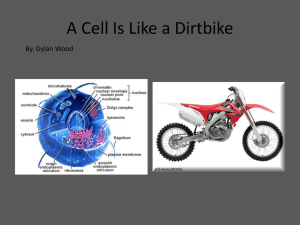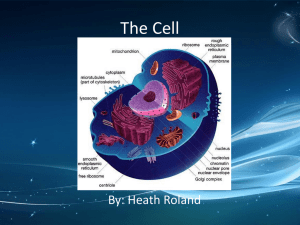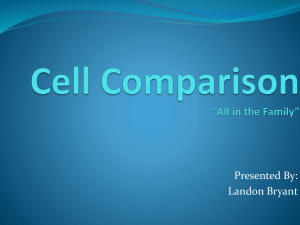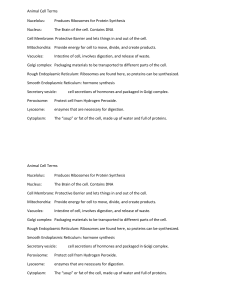Name: : :___ Cell Structure Questions ANSWER KEY Use the
advertisement
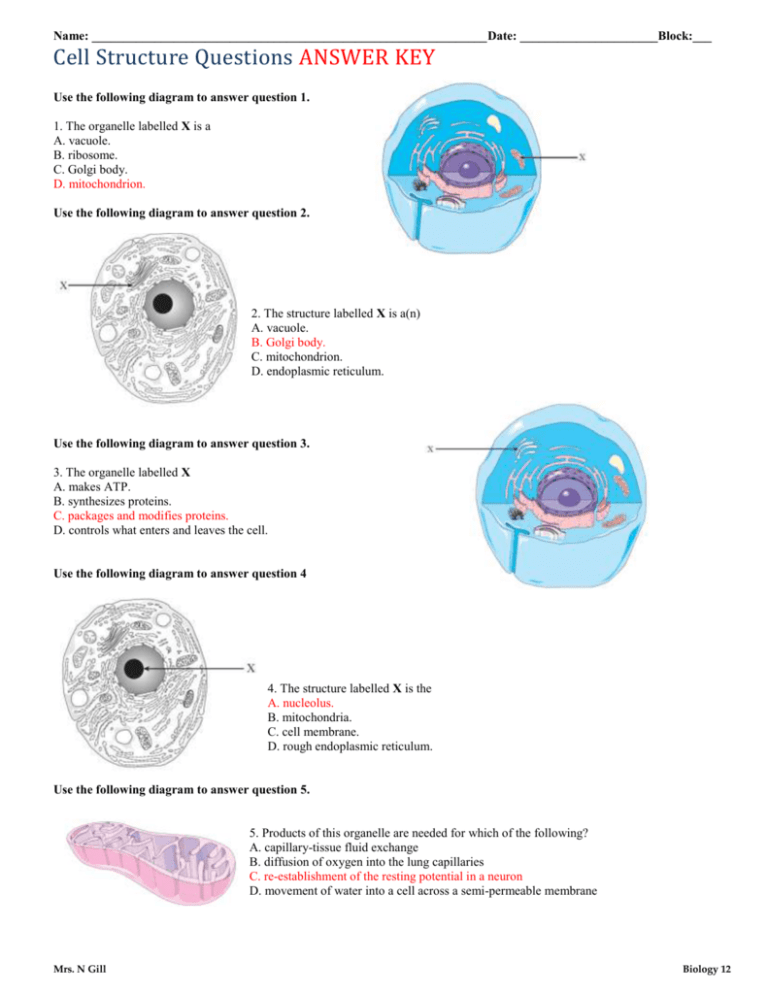
Name: _______________________________________________________________Date: ______________________Block:___ Cell Structure Questions ANSWER KEY Use the following diagram to answer question 1. 1. The organelle labelled X is a A. vacuole. B. ribosome. C. Golgi body. D. mitochondrion. Use the following diagram to answer question 2. 2. The structure labelled X is a(n) A. vacuole. B. Golgi body. C. mitochondrion. D. endoplasmic reticulum. Use the following diagram to answer question 3. 3. The organelle labelled X A. makes ATP. B. synthesizes proteins. C. packages and modifies proteins. D. controls what enters and leaves the cell. Use the following diagram to answer question 4 4. The structure labelled X is the A. nucleolus. B. mitochondria. C. cell membrane. D. rough endoplasmic reticulum. Use the following diagram to answer question 5. 5. Products of this organelle are needed for which of the following? A. capillary-tissue fluid exchange B. diffusion of oxygen into the lung capillaries C. re-establishment of the resting potential in a neuron D. movement of water into a cell across a semi-permeable membrane Mrs. N Gill Biology 12 Name: _______________________________________________________________Date: ______________________Block:___ Use the following diagrams to answer question 6. 6. Which of the following describes the sequence in which the above events would occur in the production and secretion of a protein? A. W, X, Y, Z B. W, Z, X, Y C. X, Y, W, Z D. X, Y, Z, W 7. How many of the following molecules are produced at ribosomes? glycogen testosterone phospholipids salivary amylase DNA polymerase A. one B. two C. three D. four 8. The majority of cell processes are controlled by the A. nucleus. B. lysosome. C. mitochondria. D. endoplasmic reticulum. 9. The products of mitochondria include ATP and A. water. B. lipids. C. oxygen. D. glucose. Use the following diagram to answer question 10. 10. The function of the organelle shown in the diagram is to A. produce ATP. B. detoxify alcohol. C. package molecules. D. synthesize nucleic acids. 11. Cells that contain large amounts of smooth endoplasmic reticulum, Golgi bodies and vesicles are found in which of the following? A. liver and testes B. testes and alveoli C. stomach and liver D. stomach and alveoli 12. The organelle shown on the right is the A. nucleus. B. Golgi body. C. mitochondrion. D. endoplasmic reticulum. Mrs. N Gill Biology 12 Name: _______________________________________________________________Date: ______________________Block:___ 13. Most of the protein produced by a cell is manufactured at the A. nucleus. B. vacuoles. C. rough endoplasmic reticulum. D. smooth endoplasmic reticulum. 14. Which structure is responsible for endocytosis? A. nucleolus B. Golgi body C. cell membrane D. endoplasmic reticulum Use the following diagram to answer questions 15 and 16. 15. The structure labelled X is the A. ribosome. B. Golgi body. C. mitochondrion. D. endoplasmic reticulum. 16. The function of the structure labelled Y is A. phagocytosis. B. steroid synthesis. C. cellular respiration. D. selective re-absorption. 17. Which of the following cells of equal volume would be the most efficient at absorbing nutrients as well as synthesizing and secreting a product? B 18. The products of reactions at the rough endoplasmic reticulum are transported in A. cilia. B. vesicles. C. nucleoli. D. mitochondria. Use the following diagram to answer questions 19, 20, and 21. 19. What occurs at the site of the structure labelled V? A. translation B. ATP formation C. rRNA synthesis D. DNA replication 20. Drugs are detoxified at which structure? A. W B. X C. Y D. Z 21. Which of the following is the correct sequence of organelles required in the production and export of amylase? A. V W X B. V X Z C. V Z U D. W V U Mrs. N Gill Biology 12 Name: _______________________________________________________________Date: ______________________Block:___ 22. Translation occurs at which of the following organelles? A. nucleus B. vacuole C. ribosome D. nucleolus 23. What organelle contains enzymes that hydrolyze proteins? A. ribosomes B. lysosomes C. rough endoplasmic reticulum D. smooth endoplasmic reticulum Use the following diagram to answer question 24. 24. Which labelled structure modifies polypeptides produced at the rough endoplasmic reticulum? A. W B. X C. Y D. Z 25. What could be produced by a cell with a large amount of smooth endoplasmic reticulum? A. enzymes B. antibodies C. hemoglobin D. testosterone Use the following diagram to answer question 26. 26. a) Name an organ whose cells contain large amounts of the organelle shown in the diagram.(1 mark) • liver• testes• ovaries• adrenal gland any one for 1 mark b) Describe two functions of the organelle. (2 marks) • to produce lipids• to detoxify drugs• to form vesicles to transport molecules• to produce steroid hormones (or any specific example) any two for 1 mark each 30. Describe how the function of the cell membrane, vacuoles and lysosomes are related. (3 marks) • The cell membrane folds in to produce a vacuole.• The vacuole contains food or large particles.• The lysosome binds to the vacuole.• Hydrolytic enzymes in the lysosome break down the molecules within the vacuole. any three for 1 mark each 27. The function of structure X in the diagram on the right is to A. store water. B. produce ATP. C. hydrolyze waste. D. control cellular activities. 28. A stack of saccules that prepares secretory vesicles is known as a A. plastid. B. lysosome. C. nucleolus. D. Golgi body. 29. Which of the organelles in the diagram ON THE LEFT is capable of synthesizing steroid hormones and detoxifying drugs? A. W B. X C. Y D. Z 30. Cell membranes are composed mainly of A. sugars and phosphates. B. phospholipids and proteins. C. carbohydrates and cellulose. D. nucleotides and carbohydrates. Mrs. N Gill Biology 12
